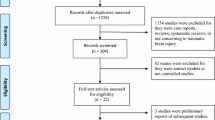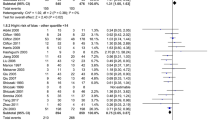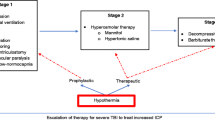Abstract
Purpose
Hypothermia therapy shows its unique potential for reducing mortality in animal study and improving neurologic outcome in patients with traumatic brain injury. However, therapeutic hypothermia for pediatric traumatic brain injury remains a controversial issue. To determine the effectiveness and safety of hypothermia treatment for pediatric traumatic brain injury patients, we conducted this meta-analysis.
Patients and methods
We analyzed the data from MEDLINE, Pubmed, EMBASE, and Cochrane Library by electronic searching. No limitation of language was selected for analysis. We extracted the mortality and adverse events from the published trials.
Results
Six clinical trials and 366 pediatric patients met our inclusion criteria. Pediatric patients with traumatic brain injury treated with hypothermia had more unfavorable outcome than those in the normothermia group (RR 1.73, 95 % CI 1.06 to 2.84), and this increased risk is statistically significant. Patients with therapeutic hypothermia are slightly likely to be induced by cardiac arrhythmia, and the likelihood is also significant (RR 2.57, 95 % CI 1.01 to 6.54). Risk of pneumonia has no statistical difference between normothermia and hypothermia arms (RR 0.90, 95 % CI 0.73 to 1.12). Two of the included trials have reported their detail randomization assignment.
Conclusions
Hypothermia may slightly increase the risk of mortality in children with traumatic brain injury and the ratio of cardiac arrhythmia after this hypothermia therapy is slightly higher than that in normothermia groups. In the future, more randomized controlled trials and multicenter studies on the mechanism of therapeutic hypothermia are required.





Similar content being viewed by others
References
Clark RSB, Kochanek PM, Marion DW, Schiding JK, White M, Palmer AM, DeKosky ST (1996) Mild posttraumatic hypothermia reduces mortality after severe controlled cortical impact in rats. J Cereb Blood Flow Metab 16:253–261
Clifton GL, Jiang JY, Lyeth BG, Jenkins LW, Hamm RJ, Hayes RL (1991) Marked protection by moderate hypothermian after experimental traumatic brain injury. J Cereb Blood Flow Metab 11:114–121
Peterson K, Carson S, Carney N (2008) Hypothermia treatment for traumatic brain injury: a systematic review and meta-analysis. J Neurotrauma 25:62–71
Biswas AK, Bruce DA, Sklar FH, Bokovoy JL, Sommerauer JF (2002) Treatment of acute traumatic brain injury in children with moderate hypothermia improves intracranial hypertension. Crit Care Med 30:2742–2751
Hutchison JS, Ward RE, Lacroix J, Hebert PC, Barnes MA, Bohn DJ, Dirks PB, Doucette S, Fergusson D, Gottesman R, Joffe AR, Kirpalani HM, Meyer PG, Morris KP, Moher D, Singh RN, Skippen PW, Hypothermia Pediat Head Injury T, Canadian Crit Care Trials G (2008) Hypothermia therapy after traumatic brain injury in children. N Engl J Med 358:2447–2456
Li H, Lu G, Shi W, Zheng S (2009) Protective effect of moderate hypothermia on severe traumatic brain injury in children. J Neurotrauma 26:1905–1909
Salonia R, Empey PE, Poloyac SM, Wisniewski SR, Klamerus M, Ozawa H, Wagner AK, Ruppel R, Bell MJ, Feldman K, Adelson PD, Clark RSB, Kochanek PM (2010) Endothelin-1 is increased in cerebrospinal fluid and associated with unfavorable outcomes in children after severe traumatic brain injury. J Neurotrauma 27:1819–1825
Melo JR, Di Rocco F, Lemos-Júnior LP, Roujeau T, Thélot B, Sainte-Rose C, Meyer P, Zerah M (2009) Defenestration in children younger than 6 years old: mortality predictors in severe head trauma. Childs Nerv Syst 25:1077–1083
Adelson PD, Ragheb J, Muizelaar JP, Kanev P, Brockmeyer D, Beers SR, Brown SD, Cassidy LD, Chang YF, Levin H (2005) Phase II clinical trial of moderate hypothermia after severe traumatic brain injury in children. Neurosurgery 56:740–754
Bourdages M, Bigras J-L, Farrell CA, Hutchison JS, Lacroix J, Canadian Critical Care Trials G (2010) Cardiac arrhythmias associated with severe traumatic brain injury and hypothermia therapy. Pediatr Crit Care Med 11:408–414
Shah PS (2010) Hypothermia: a systematic review and meta-analysis of clinical trials. Semin Fetal Neonatal Med 15:238–246
Hutchison JS, Frndova H, Lo T-YM, Guerguerian A-M, Hypothermia Pediat Head Injury T, Canadian Critical Care Trials G (2010) Impact of hypotension and low cerebral perfusion pressure on outcomes in children treated with hypothermia therapy following severe traumatic brain injury: a post hoc analysis of the hypothermia pediatric head injury trial. Dev Neurosci 32:406–412
Aldrich EF, Eisenberg HM, Saydjari C, Luerssen TG, Foulkes MA, Jane JA, Marshall LF, Marmarou A, Young HF (1992) Diffuse brain-swelling in severely head-injured children—a report from the NIH traumatic coma data-bank. J Neurosurg 76:450–454
Luerssen TG, Klauber MR, Marshall LF (1988) Outcome from head injury related to patient’s age. A longitudinal prospective study of adult and pediatric head injury. J Neurosurg 68:409–416
Chambers IR, Treadwell L, Mendelow AD (2001) Determination of threshold levels of cerebral perfusion pressure and intracranial pressure in severe head injury by using receiver-operating characteristic curves: an observational study in 291 patients. J Neurosurg 94:412–416
Kokoska ER, Smith GS, Pittman T, Weber TR (1998) Early hypotension worsens neurological outcome in pediatric patients with moderately severe head trauma. J Pediatr Surg 33:333–338
Pigula FA, Wald SL, Shackford SR, Vane DW (1993) The effect of hypotension and hypoxia on children with severe head-injuries. J Pediatr Surg 28:310–314
Chambers IR, Jones PA, Lo TYM, Forsyth RJ, Fulton B, Andrews PJD, Mendelow AD, Minns RA (2006) Critical thresholds of intracranial pressure and cerebral perfusion pressure related to age in paediatric head injury. J Neurol Neurosurg Psychiatry 77:234–240
Jones PA, Chambers IR, Lo TYM, Andrews PJD, Chaudhry W, Clark A, Croft J, Forsyth R, Fulton B, Mendelow AD, Wilson G, Minns RA (2005) Quantification of secondary CPP insult severity in paediatric head injured patients using a pressure–time index. Acta Neurochir Suppl 95:29–32
Clark RSB, Kochanek PM, Dixon CE, Chen MZ, Marion DW, Heineman S, DeKosky ST, Graham SH (1997) Early neuropathologic effects of mild or moderate hypoxemia after controlled cortical impact injury in rats. J Neurotrauma 14:179–189
Ishige N, Pitts LH, Berry I, Nishimura MC, James TL (1988) The effects of hypovolemic hypotension on high-energy phosphate-metabolism of traumatized brain in rats. J Neurosurg 68:129–136
Mikrogianakis A, Shaye RE, Griffin P, Kawesa S, Lockwood J, Gendron NH, Gaboury I, Merali Z, MacKenzie AE, Hutchison JS (2007) Hypoxia alters the expression of inhibitor of apoptosis proteins after brain trauma in the mouse. J Neurotrauma 24:338–353
Tomura S, de Rivero Vaccari JP, Keane RW, Bramlett HM, Dietrich WD (2012) Effects of therapeutic hypothermia on inflammasome signaling after traumatic brain injury. J Cereb Blood Flow Metab 32:1939–1947
Beurskens CJP, Aslami H, Kuipers MT, Horn J, Vroom MB, van Kuilenburg ABP, Roelofs J, Schultz MJ, Juffermans NP (2012) Induced hypothermia is protective in a rat model of pneumococcal pneumonia associated with increased adenosine triphosphate availability and turnover. Crit Care Med 40:919–926
Mongardon N, Lemiale V, Perbet S, Dumas F, Legriel S, Guerin S, Charpentier J, Chiche JD, Mira JP, Cariou A (2010) Value of procalcitonin for diagnosis of early onset pneumonia in hypothermia-treated cardiac arrest patients. Intensive Care Med 36:92–99
Kochanek PM, Carney N, Adelson PD, Ashwal S, Bell MJ, Bratton S, Carson S, Chesnut RM, Ghajar J, Goldstein B, Grant GA, Kissoon N, Peterson K, Selden NR, Tong KA, Tasker RC, Vavilala MS, Wainwright MS, Warden CR (2012) Guidelines for the acute medical management of severe traumatic brain injury in infants, children, and adolescents-second edition introduction. Pediatr Crit Care Med 13:S3–S6
Acknowledgments
This study was supported by the National Key Basic Research Program (NKBRP) (2010CB945203), The National Natural Science Foundation of China (81271382), and the Program of Shanghai Subject Chief Scientist (09XD1403300). The authors also acknowledge Dr. Lianming Wu and Prof. Xucheng Jiang for their critical suggestion.
Author information
Authors and Affiliations
Corresponding author
Rights and permissions
About this article
Cite this article
Ma, C., He, X., Wang, L. et al. Is therapeutic hypothermia beneficial for pediatric patients with traumatic brain injury? A meta-analysis. Childs Nerv Syst 29, 979–984 (2013). https://doi.org/10.1007/s00381-013-2076-x
Received:
Accepted:
Published:
Issue Date:
DOI: https://doi.org/10.1007/s00381-013-2076-x




